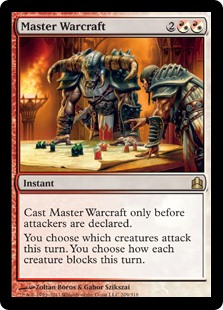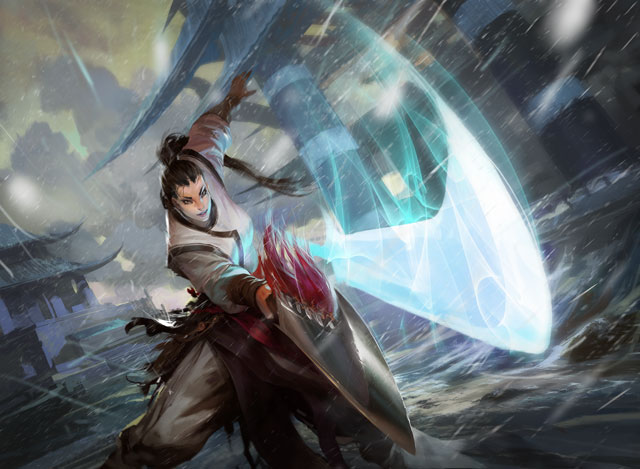Last time, we discussed how you could become a better player by just making a few changes to your game. If you didn't get a chance to read it, please click here.
Okay, now that you've had a chance to do that, lets delve into another big topic...
The Combat Step
Games are won and lost during the combat step and savvy players are able to use instants to generate large advantages at this critical juncture. It makes sense for you to learn how to use this step in your favor. There are two sides to each combat step, the attacker and the defender. In Magic, the defender has the advantage since they are able to assign blockers to attacking creatures.
In this article, I am going to cover every aspect of combat including within two articles, and this will include:
- How to declare appropriate attacks (Part I)
- How to play your cards right as the attacker (Part I)
- Ordering blockers (Part I)
- How to declare appropriate blocks (Part II)
- How to play your cards right as the defender (Part II)
Today's article will be solely focused on attacking
...
So declaring appropriate attacks?
But Sam, isn't that just turning all my guys sideways and hoping for the best?
If that was your first thought, I'm glad you're here since you need a lot of help.
But not to worry, we'll make an attacking expert out of you yet!

As a side note, you should constantly be looking at your opponent's board so you have a rough idea of how you can attack them. You should be reevaluating this with every relevant piece of information you get. Since defenders always get to choose blockers and act last, they have a big advantage.
Let's run through a few scenarios:
Scenario 1:
You: Hill Giant (not summoning sick) in play, no lands untapped, no cards in hand, 20 life
Your opponent: Grizzly Bears in play, no untapped lands, no cards in hand, 20 life
Do you attack here?
[toggle title="Click here for the solution."]
This is the simplest scenario and yes you should be attacking because your opponent has no good blocks and can never have a combat trick.
[/toggle]
Scenario 2:
You: Hill Giant (not summoning sick) in play, no lands untapped, no cards in hand, 6 life
Your opponent: Grizzly Bears in play, no untapped lands, no cards in hand, 20 life
Do you attack here?
[toggle title="Click here for the solution."]
Despite your opponent not having any good blocks, this attack would allow them to attack back. If you both drew nothing relevant for the rest of the game, it would take 7 attacks from your giant to deplete their life total and just 3 attacks from their bear to finish you off. In this case, by attacking you would be setting up an unfavorable race (attacking back and forth with your opponent).
The life totals would look like this:
Your Turn: 6 - 17
Opp's Turn: 4 - 17
Your Turn: 4 - 14
Opp's Turn: 2 - 14
Your Turn: 2 - 11
Opp's Turn: 0 - 11 (dead)
When you are racing against an opponent, you have to determine, if this is a race you can win.
[/toggle]
Scenario 3:
You: Shivan Dragon (not summoning sick) in play, 4 mountains and 4 forests untapped, no cards in hand, 6 life
Your opponent: Grizzly Bears in play, no untapped lands, no cards in hand, 20 life
Do you attack here?
[toggle title="Click here for the solution."]
Yes! In this case you would be winning the race as you are trading 8 damage for 2 damage from your opponent. The life total's will look like this:
Your Turn: 6-12
Opp's Turn: 4-12
Your Turn: 4-4
Opp's Turn: 2-4
Your Turn: 2-0 (victory!)
Now that you grasp the concept of racing. Let's raise the stakes and add multiple creatures to the fray.
[/toggle]
Scenario 4:
You: Hill Giant (not summoning sick) in play, no lands untapped, no cards in hand, 20 life
Your opponent: 2 Grizzly Bears in play, no untapped lands, no cards in hand, 20 life
Do you attack here?
[toggle title="Click here for the solution."]
No. In this case, since you have no cards you cannot represent a combat trick. This makes it a terrible attack. Not only are you losing the race (by trading 3 damage for 4) but a savvy player would pick up the trade with a double block resulting in you trading your Hill Giant for one of their Grizzly Bears.
[/toggle]
Scenario 5:
You: 2 Hill Giants (not summoning sick) in play, no lands untapped, no cards in hand, 20 life
Your opponent: 2 Grizzly Bears in play, no untapped lands, no cards in hand, 6 life
Do you attack here?
[toggle title="Click here for the solution."]
Yes. This is a very different scenario than the one above. Your opponent can choose to double block a Hill Giant (definitely a better option than just chump blocking one or both of the Giants) but they will fall to three life and will only have one Grizzly Bears remaining. If they miss on their draw step they will be forced into chump blocking with their remaining Grizzly Bears to prevent taking lethal damage.
Now lets add combat tricks to the fray:
[/toggle]
Scenario 6:
You: 1 Hill Giants (not summoning sick) in play, 2 mountains and 2 forests untapped, Shock as only card in hand, 20 life
Your opponent: 2 Grizzly Bears in play, no untapped lands, no cards in hand, 20 life
Do you attack here?
[toggle title="Click here for the solution."]
No. At 20 life, most players will not risk a double block, and you'll end up trading 4 damage for 3 damage which is not a favorable race for you. You will then be forced to cast a Shock on your opponent's Grizzly Bears which is already made irrelevant by the Hill Giant. Magic is a game of resource management, and being able to line up your cards more favorably against your opponent is what will dictate how a game will typically end. When you have a board like this and a removal spell in your hand, you want to make sure you consider all scenarios. On the plus side, if your opponent's deck has Giant Growth type effects, then the Shock's value increases as you can hold back the Hill Giant to block their creature and cast Shock only in response to a pump effect.
This attack is better if you have another creature in your hand that you can play after combat. For example, if you had an Elvish Warrior that you could cast in the post-combat main phase, then you're effectively forcing your opponent to 2 for 1 themselves or lose 3 life a turn. On the flip side, if you know your opponent has multiple Giant Growth's in their deck, the worst situation is when they double block and you cast Shock on a Grizzly Bears to which they respond with Giant Growth, which will end up trading your Hill Giant and Shock for a Grizzly Bears. Doesn't that sound awful? Most limited formats have green commons that will punish damage based removal after blocks are declared. A competent opponent is never going to cast a spell before they have to, so while these 2 for 1's may look inviting, this is a common trap that can make you not only lose card advantage but tempo as well.
[/toggle]
Scenario 7:
You: 1 Stampeding Rhino (not summoning sick) in play, 3 untapped mountains and 3 untapped forests, Hill Giant as only card in hand, 20 life
Your opponent: 1 Elvish Visionary, 1 Grizzly Bears and in play, 1 untapped forest, 2 cards in hand, 20 life
Do you attack here?
Yes. There are very few cards that punish you in this situation and you have a creature to play post combat that will prevent your opponent from attacking.
Oh wait, wasn't that supposed to be in the solution section?
Your opponent frantically double blocks your Stampeding Rhino. How do you assign blocks?
[toggle title="Click here for the solution."]
Most players typically will just order the blocks in whatever cards are closer without giving it much thought. But as you saw from the previous example, we want to use tricks to determine how we will determine what creature is dealt damage first. The most likely card our opponent could have since they double blocked in this situation is Giant Growth. If we were to put Grizzly Bears first and then Elvish Visionary, our opponent could cast Giant Growth on the Grizzly Bears and save both creatures.
If we put Elvish Visionary first, then if they have Giant Growth, they still lose the Elvish Visionary. And if our opponent misread their hand, then we will kill both creatures.
So in this situation, you should always order Elvish Visionary first, and then Grizzly Bears.
[/toggle]
Summary:
When deciding your attacks, make sure you consider the following:
- Am I setting up a race that I can win?
- Is it worth trading my resources in the way I am potentially allowing my opponent to?
- What tricks could my opponent have, and should I hold back my creature as a result?
- In what order should I assign damage to my opponent's blockers to prevent blowouts by tricks that I think they could have?
Of course, there are definitely a lot more complexities than those that I mentioned in the scenarios above, including enabling Revolt or playing around Haste creatures that can swing a race in your opponent's favor. This article is to give you a baseline understanding that you will adapt to the various intricacies of a format. I look forward to continuing this series next week with Part II, where we will focus on how to block optimally.
Post in the comments below or tweet at me (@SammyTMTG). And, if you want to keep up with my articles and happenings, please make sure you hit the follow button for Twitter @ SammyTMTG. I’ll see you next week for another article on improving your magical skills!
Until then, have a great weekend!
Sammy T


